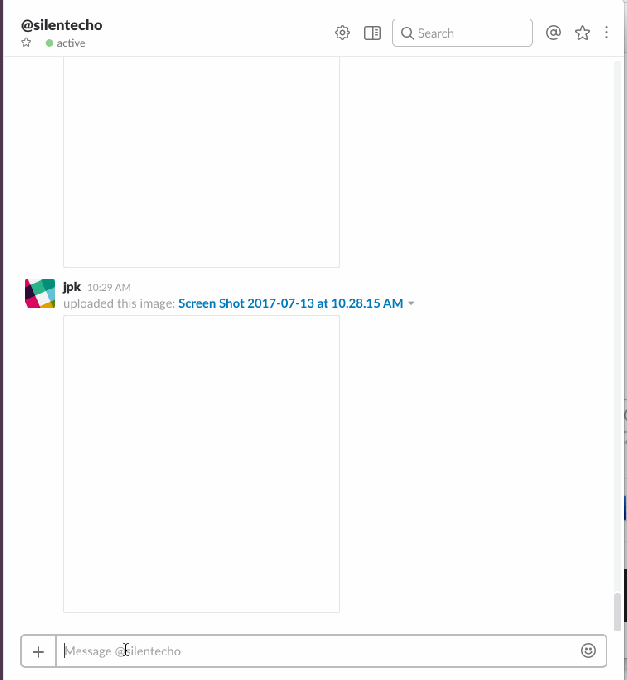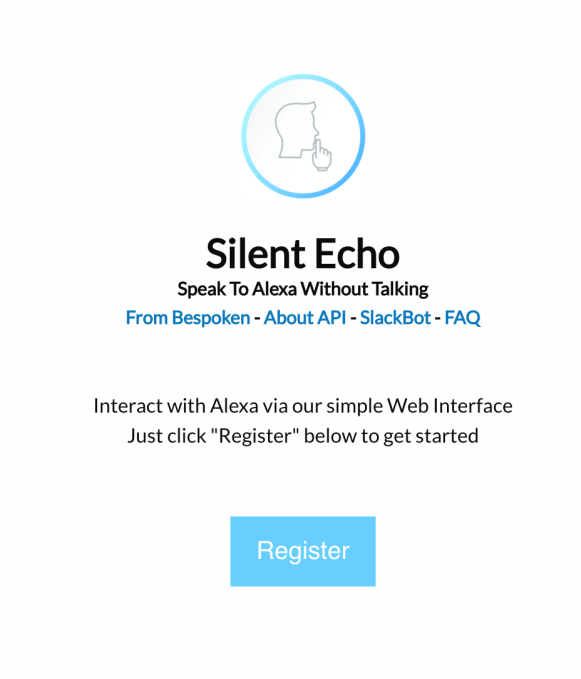Silent Echo lets you chat with Alexa over Slack

Want to chat with Alexa via Slack? A new bot called Silent Echo now makes that possible. The idea is that there are times when you want to interact with Amazon’s virtual assistant, Alexa, but you don’t want to do it by voice. For example, if things are too noisy in the room for Alexa to properly hear you, or, alternately, if you need things to be very quiet.
The service doesn’t offer the full capabilities that Alexa offers on other platforms, like Amazon’s Echo speaker. For example, Silent Echo doesn’t let you control Spotify or other music services, nor can it handle using Alexa skills that require multiple turns due to its short session times.
But there are things Silent Echo can handle, like the ability to control smart home devices or the ability interact with Alexa skills – including for testing purposes, as developers may need to do.
In fact, the idea for Silent Echo comes from Bespoken, a company offering tools for developing voice apps. Bespoken spun out of interactive audio ad company XappMedia last year, and has since released a number of open source command line tools which have been adopted by nearly 700 voice app developers. These tools help Bespoken to gain exposure for its SaaS product, a logging and monitoring software solution for Alexa and Google Home voice apps.
Today, that software is being used by around 150 customers – mainly agencies working with bigger brands on voice app development.
According to John Kelvie, founder and CEO at Bespoken, the team originally built a web client version of Silent Echo in order to support some functionality in the company’s enterprise voice application solution. But a number of people asked if they could get a version of this for Slack, leading to the creation of the new Slackbot.
Once installed in Slack, you can direct message the Silent Echo bot or call it up in a group chat by addressing messages to @silentecho.
The bot works by converting what you type in Slack into audio using text-to-speech, which is then sent to Alexa using Amazon’s own APIs. The audio reply Alexa returns is then converted back into text using speech-to-text.

This is an unofficial means of using Alexa – so technically speaking, it’s something of a hack. However, it’s all being done using “openly available routines,” says Kelvie. “We are not doing anything sneaky or relying on any private APIs or loopholes,” he explains.
Essentially, Silent Echo acts like a virtual Alexa device, so it’s tied to your own Alexa account. That means it has access to your Amazon account information and any skills you’ve added.
But for security purposes, the group chat interactions with Silent Echo instead use a generic Silent Echo instance, which is linked to an Amazon account with limited privileges. You can still add skills to this version, but not those that require you to link them with a personal account – like a skill that lets you order a pizza to your house, for example.

You should be aware that the requests and responses are stored in Bespoken’s database, which will not be shared, but could become the subject of government or law enforcement requests. Whether or not Alexa’s voice transcripts should be saved is a subject of debate as of late, as a report indicated that Amazon is considering offering private transcript data to developers to help them build better voice apps.
In Bespoken’s case, however, its transcripts wouldn’t be picking up extraneous background noise and voices, as those from Echo speakers could. It only saves the typed out requests and the translated responses for the purpose of displaying them in the user interface, Kelvie notes.
In addition to the Slackbot, Silent Echo is also available as a web client and SDK. The Slackbot, however, is proving popular.
“We’re already in 35 different Slack communities, and we’ve got over 1,000 users,” Kelvie says of the Slackbot, which the company only introduced publicly via a blog post about its beta in mid-July.
“It’s spreading rapidly,” he adds, noting that he didn’t originally think the bot would be used by more than a handful of Slack groups.
“It does make me feel optimistic about the uptake we’ll get for a Twitter version,” says Kelvie. Asked when that would arrive, he says hopefully next week. Stay tuned.
In the meantime, the Silent Echo Slackbot is free to use, here.